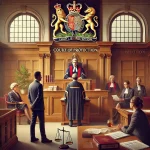Table of Contents

Key Takeaways
- Trusts are legal arrangements essential for effective estate planning in the UK.
- Understanding the different types of trusts can help you choose the best one for your needs.
- Setting up a trust can offer significant benefits, including asset protection and potential tax advantages.
- Choosing the right trustees and understanding their duties is crucial to managing a trust effectively.
- A trust can be set up during your lifetime or through your will, with each approach having its own implications.
Demystifying Trusts in UK Estate Planning
When it comes to securing your family’s financial future, understanding the role of trusts in estate planning is a game-changer. Trusts aren’t just for the wealthy; they’re a tool that can offer peace of mind and ensure that your assets are managed according to your wishes, both during your lifetime and after you’re gone. So, let’s dive in and unravel the mysteries of UK trust law together.
What is a Trust?
A trust is like a safety deposit box where you can keep your valuable assets, but you hand over the key to someone you trust, called a trustee. They’re responsible for taking care of what’s inside for the benefit of someone else, known as the beneficiary. It’s a way to control and protect your assets, making sure they’re used in the way you intended, whether that’s for your children’s education, supporting a loved one with special needs, or any other purpose you have in mind.
Why Trusts are Vital in Estate Planning
Trusts are a cornerstone of estate planning for a good reason. They offer control over your assets and can help reduce the amount of Inheritance Tax that might be due upon your death. Besides that, they provide a level of protection for your assets against creditors or in the event of divorce and can ensure that those who might not be ready or able to manage a large sum of money are cared for in the long term.
The Building Blocks of a Secure Future
Will Writing and Trust Integration
Writing a will is a critical step in estate planning, but integrating a trust into your will can take your forward-thinking to the next level. It’s like writing a script for your assets, guiding your trustees on how to manage and distribute your wealth when you’re not around to make those decisions yourself. Therefore, it’s vital to be clear about your intentions and the rules of the trust when you’re setting it up.
The Role of Executors and Trustees
Executors and trustees often wear different hats. Your executor is the person who carries out the instructions in your will, while the trustee manages any trusts that are set up. They can be the same person, but they don’t have to be. The key is to choose someone who is responsible, trustworthy, and ideally, has a good head for finances.
Exploring Types of Trusts
Think of trusts as a collection of different vehicles, each designed for specific journeys. Let’s explore a few common types to help you find the right fit for your estate planning journey.
Bare Trusts: Simple but Effective
Bare trusts are the simplest type of trust. You put assets into a trust for a beneficiary who gains absolute right to them at age 18 (in England and Wales) or 16 (in Scotland). It’s straightforward, but remember, once the beneficiary is of age, they’re free to do what they want with the assets.
Discretionary Trusts: Flexibility for the Future
With a discretionary trust, you give your trustees the power to make decisions about how to use the trust income and sometimes the capital, depending on the needs of the beneficiaries. It’s like giving them a toolbox where they can choose the right tool for the job at the right time.
Most importantly, a discretionary trust is about flexibility. You can include a variety of beneficiaries and change them over time, which is ideal if you want to provide for a changing family dynamic.
Interest in Possession Trusts and Inheritance Tax
Interest in possession trusts are often used when you want someone to benefit from the income of the trust during their lifetime, with the capital going to another person later on. For instance, you might want your spouse to receive the income from your investments while they live, with the principal going to your children after your spouse’s death.
But there’s a catch – these trusts can have tax implications, particularly concerning Inheritance Tax, so it’s crucial to get advice to ensure they’re set up correctly.
Protective and Charitable Trusts
Protective trusts are designed to safeguard the interests of a beneficiary who might not be able to manage the funds themselves, while charitable trusts support charitable causes. Each serves a specific purpose and can be a powerful tool in your estate planning arsenal.
| Trust Type | Description |
|---|---|
| Bare Trust | Simple trust where beneficiary gains absolute right to assets at age 18 (England/Wales) or 16 (Scotland). |
| Discretionary Trust | Trustees have discretion over how to use income and capital based on beneficiaries’ needs. Allows flexibility and changing beneficiaries over time. |
| Interest in Possession Trust | Beneficiary receives income from trust during lifetime, with capital passing to others later. Tax implications, especially for Inheritance Tax.12 |
| Protective Trust | Designed to safeguard interests of beneficiaries who cannot manage funds themselves. |
| Charitable Trust | Supports charitable causes as beneficiary. |
Maximising Benefits Through Trusts
Asset Protection and Tax Considerations
One of the most compelling reasons to set up a trust is the protection it offers. Your assets are essentially ring-fenced, which means they’re kept separate from your personal financial affairs. This can be particularly advantageous if your beneficiaries are not yet of age or if you’re concerned about their ability to manage a large inheritance. Besides that, a trust can provide a shield against creditors or in the event of divorce, ensuring that the wealth you’ve accumulated is passed on as you intend.
From a tax perspective, trusts can be incredibly beneficial. Assets placed in a trust may be exempt from Inheritance Tax if you live for seven years after putting them in the trust. This is known as the ‘seven-year rule’ and is a crucial aspect of estate planning. By effectively managing a trust, you can minimize the tax burden on your estate, ensuring more of your wealth goes to your loved ones.
However, it’s important to note that trusts are subject to their own tax regimes, including Income Tax, Capital Gains Tax, and Inheritance Tax, depending on the type of trust and the assets involved. Therefore, it’s essential to get professional advice to navigate these complexities and ensure your trust is as tax-efficient as possible.
- Protect assets from personal financial risks.
- Minimize potential Inheritance Tax liabilities.
- Consider the ‘seven-year rule’ for gifts into trusts.
- Seek professional advice to navigate trust taxes.
Trusts for Vulnerable Beneficiaries
Trusts are particularly useful when you have beneficiaries who might be vulnerable due to age, disability, or other circumstances. For example, a trust can ensure that a child with a disability is provided for throughout their life without directly giving them assets that they may not be able to manage. This can also protect their eligibility for means-tested benefits, which could be jeopardized by a direct inheritance.
Continuity and Control of Family Assets
Creating a trust can also maintain continuity and control over family assets. For instance, a family business can be placed into a trust to ensure that it continues to operate according to the family’s wishes, even after the death of the founder. Trusts can also be structured to provide for educational expenses, support philanthropic efforts, or preserve family wealth across generations.
Most importantly, trusts allow you to set conditions on how and when your assets are distributed, giving you a voice in the future handling of your estate and ensuring your wishes are followed.
Step-by-Step Guide: Setting Up a Trust
Choosing the Right Trust for Your Needs
Choosing the right trust depends on your specific circumstances and goals. Here’s a simple guide to get you started:
- Define your objectives: Are you looking to protect assets, provide for someone with a disability, or reduce Inheritance Tax?
- Identify the beneficiaries: Who do you want to benefit from the trust? Consider their circumstances and needs.
- Decide on the type of trust: Bare, discretionary, interest in possession, or another type?
- Consult with an expert: Speak to a solicitor or financial advisor to ensure the trust aligns with your goals and is set up correctly.
Once you’ve chosen the right type of trust, the next step is to establish it formally, which involves creating a trust deed—a legal document that sets out the rules of the trust.
Appointing Trustees and Outlining Their Duties
Trustees are the linchpin of a trust, and their role cannot be overstated. When appointing trustees, consider their ability to manage the trust and their relationship with the beneficiaries. It’s also wise to appoint more than one trustee to provide checks and balances.
The duties of trustees are both broad and specific, including:
- Acting in the best interest of the beneficiaries.
- Investing trust assets wisely.
- Maintaining accurate records and accounts.
- Complying with the trust deed and the law.
It’s essential that trustees understand these responsibilities, as they are legally accountable for their actions in managing the trust.
Understanding the Legal Framework of Trusts
The legal framework surrounding trusts in the UK is robust and designed to protect the interests of all parties involved. The key legislation includes the Trustee Act 1925, the Trustee Act 2000, and various other laws and regulations that govern how trusts are set up and administered.
Understanding these laws is crucial because they outline the powers and duties of trustees, the rights of beneficiaries, and the tax implications of trusts. This is where professional guidance becomes invaluable, ensuring that you’re making informed decisions and that your trust complies with all legal requirements.
Trust Law: Beyond the Basics
Trusts and the UK Tax System
Trusts interact with the UK tax system in complex ways, and it’s vital to understand these nuances. For instance, the type of trust you choose will influence how it’s taxed. A discretionary trust might have different tax implications compared to an interest in possession trust, especially when it comes to Inheritance Tax and Capital Gains Tax.
It’s also important to be aware of the potential tax charges that can occur at different stages of a trust’s life: when assets are put into the trust (known as ‘entry charges’), periodically during the life of the trust (known as ‘ten-year anniversary charges’), and when assets leave the trust (known as ‘exit charges’).
When and How to Update Your Trust
Life is full of changes, and your trust should reflect that. Updating a trust is a critical part of maintaining its relevance and effectiveness. You might need to update your trust because of changes in your family, like a marriage or a new baby, or due to changes in the law that affect how trusts are taxed or managed.
To update a trust, you’ll usually need to consult with your trustees and potentially seek legal advice. Any changes should be made in writing and in accordance with the trust deed and the law. It’s a good practice to review your trust regularly, at least every five years, or after significant life events.
The Final Piece: Utilising Trusts Effectively
Now that we’ve laid the groundwork, it’s time to look at how to utilize trusts effectively. A trust is a powerful vehicle, but like any vehicle, it needs to be driven correctly. The key is to ensure that the trust is used in a way that aligns with your overall estate planning goals. This means regularly reviewing the trust’s performance, ensuring it’s adequately funded, and that it continues to serve the best interests of the beneficiaries.
Managing a Trust: Ongoing Responsibilities
Managing a trust is an ongoing responsibility that shouldn’t be taken lightly. Trustees have a legal obligation to act in the best interest of the beneficiaries and manage the trust assets responsibly. This includes investing the assets wisely, keeping detailed records, and preparing annual accounts. Trustees must also stay informed about any changes in the law that might affect the trust and ensure that they’re always acting within the legal framework.
Key Considerations for Trusts in Estate Planning
When incorporating trusts into your estate planning, it’s important to keep a few key considerations in mind:
- Long-term vision: Think about what you want to achieve with your trust in the long term. Are you looking to provide for your children’s education, protect a family business, or support a charitable cause?
- Beneficiary needs: Consider the current and future needs of your beneficiaries. A trust can be tailored to accommodate those needs over time.
- Flexibility: Estate planning is not a one-size-fits-all approach. Your trust should be flexible enough to adapt to changes in your circumstances or objectives.
By keeping these factors at the forefront, you can ensure that your trust remains a valuable part of your estate planning strategy.
Frequently Asked Questions (FAQ)
Can Trusts Only be Created Upon Death?
No, trusts can be created during your lifetime (these are called ‘living trusts’) or upon your death (typically through your will). Living trusts can provide benefits during your lifetime, such as asset protection and tax planning opportunities.
Are Trusts Only for the Wealthy?
Trusts are not just for the wealthy; they can be beneficial for anyone who wants to manage their assets in a specific way. Whether you’re looking to protect assets for future generations, provide for a vulnerable family member, or support charitable causes, trusts can be an effective tool regardless of the size of your estate.
How Does a Trust Reduce Inheritance Tax?
Trusts can reduce Inheritance Tax by removing assets from your estate. For example, if you set up a trust and survive for at least seven years after transferring assets into it, those assets may not be subject to Inheritance Tax upon your death. However, trusts themselves may be subject to other taxes, so it’s essential to seek professional advice.
What Happens to a Trust if a Trustee Dies?
If a trustee dies, the remaining trustees can continue to manage the trust. If there are no surviving trustees, or the trust deed specifies that a new trustee must be appointed, the beneficiaries or the executor of the deceased trustee’s estate can appoint a new one, depending on the terms of the trust deed
Can Trusts be Contested or Revoked?
Trusts can be contested, typically during probate, if someone believes the trust was created under duress, through fraud, or by someone lacking mental capacity. As for revoking a trust, it depends on whether it’s revocable or irrevocable. Revocable trusts can be altered or revoked by the settlor during their lifetime, while irrevocable trusts generally cannot be changed once they’re established.






